Effects of flecainide and quinidine on arrhythmogenic properties of Scn5a+/- murine hearts modelling the Brugada syndrome
- PMID: 17303635
- PMCID: PMC2075209
- DOI: 10.1113/jphysiol.2007.128785
Effects of flecainide and quinidine on arrhythmogenic properties of Scn5a+/- murine hearts modelling the Brugada syndrome
Abstract
Brugada syndrome (BrS) is associated with a loss of Na+ channel function and an increased incidence of rapid polymorphic ventricular tachycardia (VT) and sudden cardiac death. A programmed electrical stimulation (PES) technique assessed arrhythmic tendency in Langendorff-perfused wild-type (WT) and genetically modified (Scn5a+/-) 'loss-of-function' murine hearts in the presence and absence of flecainide and quinidine, and the extent to which Scn5a+/- hearts model the human BrS. Extra-stimuli (S2), applied to the right ventricular epicardium, followed trains of pacing stimuli (S1) at progressively reduced S1-S2 intervals. These triggered VT in 16 out of 29 untreated Scn5a+/- and zero out of 31 WT hearts. VT occurred in 11 out of 16 (10 microM) flecainide-treated WT and nine out of the 13 initially non-arrhythmogenic Scn5a+/- hearts treated with (1.0 microM) flecainide. Quinidine (10 microM) prevented VT in six out of six flecainide-treated WT and 13 out of the 16 arrhythmogenic Scn5a+/- hearts in parallel with its clinical effects. Paced electrogram fractionation analysis demonstrated increased electrogram durations, expressed as electrogram duration (EGD) ratios, with shortening S1-S2 intervals in arrhythmogenic Scn5a+/- hearts, and prolonged ventricular effective refractory periods (VERPs) in non-arrhythmogenic Scn5a+/- hearts. Flecainide increased EGD ratios in WT (at 10 microM) and non-arrhythmogenic Scn5a+/- hearts (at 1.0 microM), whereas quinidine (10 microM) reduced EGD ratios and prolonged VERPs in WT and arrhythmogenic Scn5a+/- hearts. However, epicardial and endocardial monophasic action potential recordings consistently demonstrated positive gradients of repolarization in WT, arrhythmogenic and non-arrhythmogenic Scn5a+/- hearts under all pharmacological conditions. Together, these findings demonstrate proarrhythmic effects of flecainide in WT and Scn5a+/- murine hearts that recapitulate its clinical effects. They further attribute the arrhythmogenic phenomena observed here to re-entrant substrates resulting from delayed epicardial activation despite an absence of transmural heterogeneities of repolarization, in sharp contrast to recent characterizations in 'gain-of-function' Scn5a+/Delta murine hearts modelling the long-QT(3) syndrome.
Figures

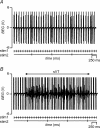

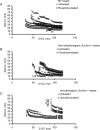

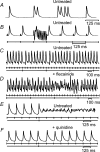
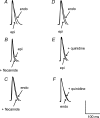

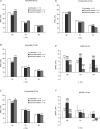
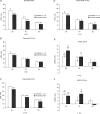

Similar articles
-
Effects of flecainide and quinidine on arrhythmogenic properties of Scn5a+/Delta murine hearts modelling long QT syndrome 3.J Physiol. 2007 Jan 1;578(Pt 1):69-84. doi: 10.1113/jphysiol.2006.117945. Epub 2006 Oct 5. J Physiol. 2007. PMID: 17023504 Free PMC article.
-
Refractory dispersion promotes conduction disturbance and arrhythmias in a Scn5a (+/-) mouse model.Pflugers Arch. 2011 Oct;462(4):495-504. doi: 10.1007/s00424-011-0989-3. Epub 2011 Jul 21. Pflugers Arch. 2011. PMID: 21779762 Free PMC article.
-
Atrial arrhythmogenic properties in wild-type and Scn5a+/- murine hearts.Exp Physiol. 2010 Oct;95(10):994-1007. doi: 10.1113/expphysiol.2010.053868. Epub 2010 Jul 9. Exp Physiol. 2010. PMID: 20621962
-
Transmural dispersion of repolarization and arrhythmogenicity: the Brugada syndrome versus the long QT syndrome.J Electrocardiol. 1999;32 Suppl:158-65. doi: 10.1016/s0022-0736(99)90074-2. J Electrocardiol. 1999. PMID: 10688320 Review.
-
Clinical Spectrum of SCN5A Mutations: Long QT Syndrome, Brugada Syndrome, and Cardiomyopathy.JACC Clin Electrophysiol. 2018 May;4(5):569-579. doi: 10.1016/j.jacep.2018.03.006. Epub 2018 May 2. JACC Clin Electrophysiol. 2018. PMID: 29798782 Review.
Cited by
-
Minimizing repolarization-related proarrhythmic risk in drug development and clinical practice.Drugs. 2010 Mar 26;70(5):573-603. doi: 10.2165/11535230-000000000-00000. Drugs. 2010. PMID: 20329805 Review.
-
Spatial and temporal heterogeneities are localized to the right ventricular outflow tract in a heterozygotic Scn5a mouse model.Am J Physiol Heart Circ Physiol. 2011 Feb;300(2):H605-16. doi: 10.1152/ajpheart.00824.2010. Epub 2010 Nov 19. Am J Physiol Heart Circ Physiol. 2011. PMID: 21097662 Free PMC article.
-
Ion channels, long QT syndrome and arrhythmogenesis in ageing.Clin Exp Pharmacol Physiol. 2017 Dec;44 Suppl 1(Suppl Suppl 1):38-45. doi: 10.1111/1440-1681.12721. Epub 2017 Sep 20. Clin Exp Pharmacol Physiol. 2017. PMID: 28024120 Free PMC article. Review.
-
Voltage-gated sodium channels in excitable cells as drug targets.Nat Rev Drug Discov. 2025 May;24(5):358-378. doi: 10.1038/s41573-024-01108-x. Epub 2025 Feb 3. Nat Rev Drug Discov. 2025. PMID: 39901031 Review.
-
Scn3b knockout mice exhibit abnormal ventricular electrophysiological properties.Prog Biophys Mol Biol. 2008 Oct-Nov;98(2-3):251-66. doi: 10.1016/j.pbiomolbio.2009.01.005. Epub 2009 Jan 24. Prog Biophys Mol Biol. 2008. PMID: 19351516 Free PMC article.
References
-
- Akar FG, Wu RC, Deschenes I, Armoundas AA, Piacentino V, 3rd, Houser SR, Tomaselli GF. Phenotypic differences in transient outward K+ current of human and canine ventricular myocytes: insights into molecular composition of ventricular Ito. Am J Physiol Heart Circ Physiol. 2004;286:H602–H609. - PubMed
-
- Alings M, Dekker L, Sadee A, Wilde A. Quinidine-induced electrocardiographic normalization in two patients with Brugada syndrome. Pacing Clin Electrophysiol. 2001;24:1420–1422. - PubMed
-
- Alings M, Wilde A. ‘Brugada’ syndrome: clinical data and suggested pathophysiological mechanism. Circulation. 1999;99:666–673. - PubMed
-
- Anderson JL, Platia EV, Hallstrom A, Henthorn RW, Buckingham TA, Carlson MD, Carson PE. Interaction of baseline characteristics with the hazard of encainide, flecainide, and moricizine therapy in patients with myocardial infarction. A possible explanation for increased mortality in the Cardiac Arrhythmia Suppression Trial (CAST) Circulation. 1994;90:2843–2852. - PubMed
-
- Anno T, Hondeghem LM. Interactions of flecainide with guinea pig cardiac sodium channels. Importance of activation unblocking to the voltage dependence of recovery. Circ Res. 1990;66:789–803. - PubMed
Publication types
MeSH terms
Substances
Grants and funding
LinkOut - more resources
Full Text Sources
Miscellaneous

